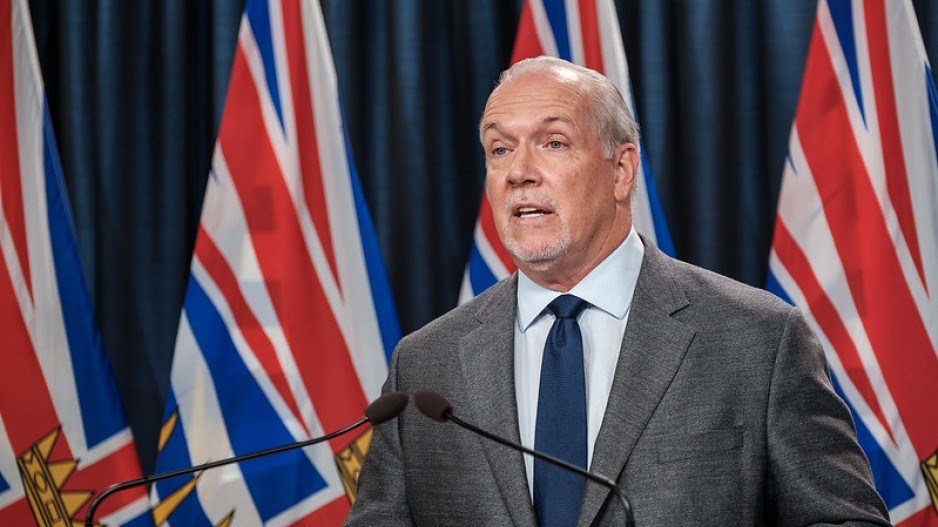For the first time in 24 years, the NDP is poised to form a majority government in B.C. and continue leading the province through the worsening COVID-19 pandemic.
The NDP retained a healthy lead in polls during the short campaign and, according to the Urban Development Institute, the election results also hold few surprises for the residential real estate industry.
Preliminary election results released on the October 24 election night showed the NDP leading or elected in 55 of the province’s 87 constituencies, with the Liberals ahead in 29 and the Greens leading in three.
If the results hold, the party will surpass the 51 seats it won in 1991 and John Horgan, who took a gamble by calling a snap election in the middle of the pandemic, will become the first NDP premier to be re-elected in the province’s history.
“I want to assure people I’m going to keep the focus right where it belongs, on helping people get through this pandemic, making sure they have the services that they need and all British Columbians can sleep safely knowing we’re going to do everything we can to keep them safe, healthy and secure,” Horgan said.
By contrast, it was clear from the results that Liberal Leader Andrew Wilkinson failed to connect with voters during the campaign, despite promising to scrap the provincial sales tax for one year at a cost of about $7 billion.
The Liberals, which won 43 seats in 2017, could have 14 fewer this time around.
Early results show that voter share for the Liberals has fallen from 54 per cent or more in elections prior to 2000 to 40 per cent in the 2017 election and to 35 per cent this election, based on current results.
The final results won’t be known for weeks, with Elections B.C. scheduled to begin counting about half a million mail-in and absentee ballots on November 6.
“It would be definitely surprising if the level of support for the liberals grew with the mail-in ballots at a level that is higher than what they had [on election night],” said Mario Canseco president of Research Co.
The major television stations, which rely on complicated formulas to project winners and losers, declared an NDP majority government less than 90 minutes after the polls closed.
Political observers attributed the NDP’s strong showing to overall satisfaction with the NDP government and particularly its handling of the pandemic to date.
“I think it just says overall — ‘We think you’ve done well. Stay the course,’ ” said Daniel Reeve, a political science instructor at Camosun College.
Reeve said the Liberals seemed “flat-footed” throughout the campaign, and he predicted the party will be looking for a new leader in the coming months. “Wilkinson will either resign or be pushed out,” he said.
Wilkinson acknowledged in a short speech in Vancouver just after 10:15 p.m. that it appeared the NDP will have the opportunity to form government.
“But with almost half a million mail-in ballots still to be counted, we don’t know what the final outcome will be,” he said. “And we owe it to every voter, no matter how they express their intention, to await the final results.”
The B.C. Green Party, meanwhile, will no longer hold the balance of power after propping up Horgan’s minority for the past three years. But the party seemed likely to hold its two seats on Vancouver Island, with Green Leader Sonia Furstenau leading in Cowichan Valley and Adam Olsen winning in Saanich North and the Islands.
Residential real estate
The election of an NDP majority will have more positive than negative impacts on the B.C. residential real estate industry, based on a critique of the NDP election platform by the Urban Development Institute (UDI) Pacific Region.
Among the “positives” outlined by the UDI is NDP promises to provide rental rebate of $400 per year for eligible households earning up to $80,000 per year and not receiving other rental supports; elimination of parking minimums for developments near transit; streamlining of provincial and permit approvals for new projects; and “single-window” provincial permitting process for new real estate developments.
The “negatives” flagged by the UDI were the provincial rent freeze on rental housing until the end of 2021, and a subsequent capping of annual rent increases at the inflation rate; and an NDP plan to allow local governments to set their own carbon pollution standards for new buildings.
“Freezing rents, without mitigating increased costs such as property taxes, insurance and utilities, removes the ability for rental providers to invest in upgrades to buildings or build new purpose-built rental,” the UDI noted in a pre-election statement.
The UDI also voiced an industry concern that different civic carbon regulations could result in inconsistent and layering standards for developers across municipalities. The UDI recommends a consistent provincial carbon pollution standards through the existing BC Energy Step Code framework.



